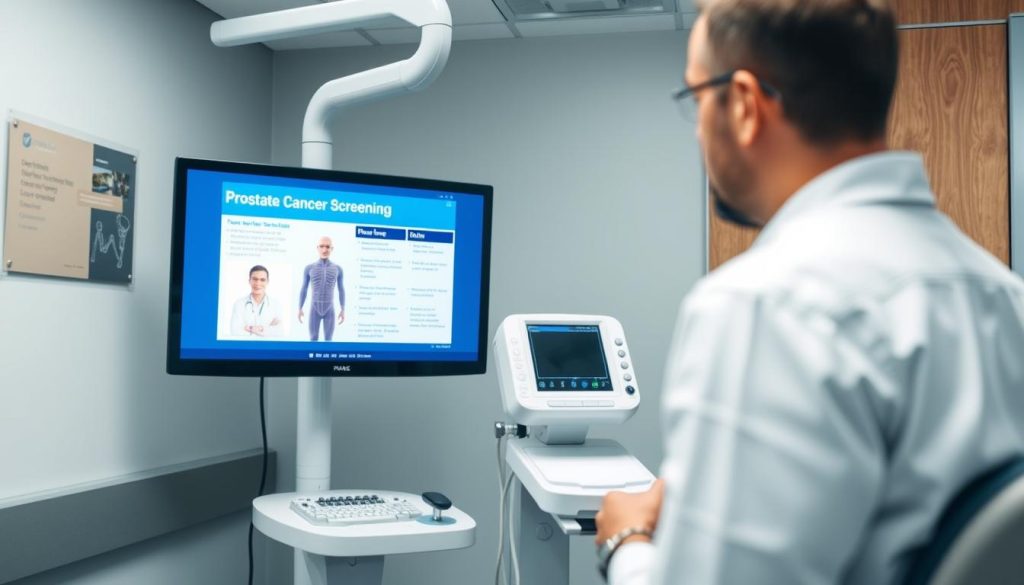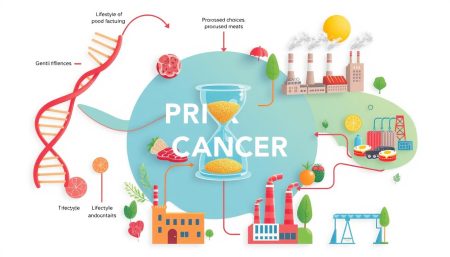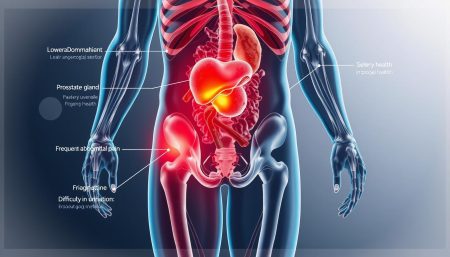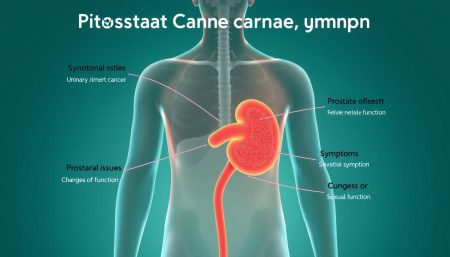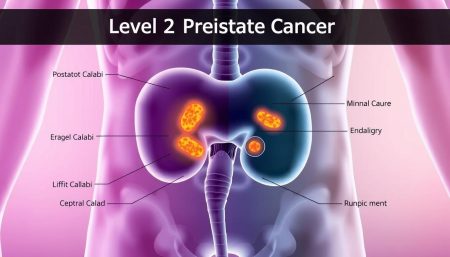Prostate cancer is a big problem for men all over the world. It’s important to know about it. This guide will help you understand prostate tumors, symptoms, and treatments.
We’ll talk about why screening is key and how early detection helps. You’ll learn how to make smart choices for your health.
We’ll cover everything from risk factors to new treatments. This info is for anyone worried about prostate cancer, whether it’s for themselves or a loved one. Our goal is to help you understand prostate health and the latest in treatment.
What is Prostate Cancer and How Does it Develop?
Prostate cancer starts in the prostate gland, a small organ found only in men. It happens when cells in the prostate grow too much and form a tumor. Knowing about the prostate and its tumors is key for early detection and treatment.
The Anatomy of the Prostate Gland
The prostate is a walnut-sized gland below the bladder and in front of the rectum. It makes seminal fluid, which helps sperm. As men get older, the prostate can grow, sometimes causing health problems like cancer.
Common Types of Prostate Tumors
Most prostate cancers are adenocarcinomas, which start in gland cells. Rare types include small cell carcinomas and neuroendocrine tumors. Each type needs a different treatment plan.
| Tumor Type | Frequency | Characteristics |
|---|---|---|
| Adenocarcinoma | 95% | Slow-growing, develops in gland cells |
| Small Cell Carcinoma | 1% | Aggressive, rare, spreads quickly |
| Neuroendocrine Tumor | Less than 1% | Rare, arises from neuroendocrine cells |
Risk Factors and Disease Progression
Several factors can raise the risk of prostate cancer. Age is a big factor, with risk going up after 50. Family history and genetics also matter. The disease often grows slowly, but can spread if not treated early. Regular screenings can help find tumors early, leading to better treatment results.
Early Warning Signs and Symptoms
Spotting prostate cancer symptoms early is key to effective treatment. Many men with early-stage prostate cancer show no signs. This makes regular screenings very important.
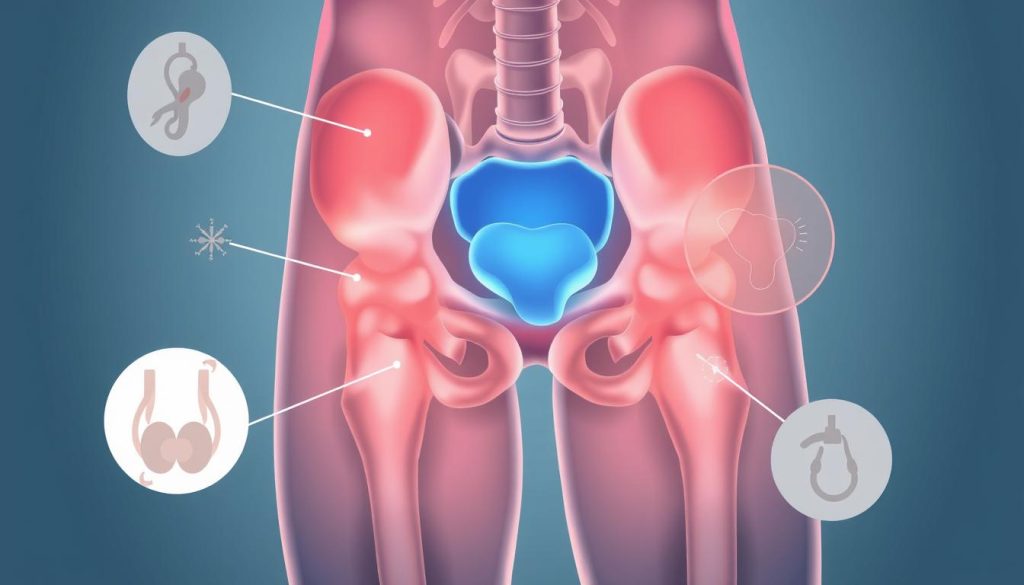
Urinary changes are common symptoms of prostate cancer. Men might notice:
- Frequent urination, often at night
- Difficulty starting or stopping urination
- Weak or interrupted urine flow
- Burning sensation during urination
Other symptoms include:
- Blood in urine or semen
- Erectile dysfunction
- Discomfort in the pelvic area
- Pain or stiffness in the lower back, hips, or upper thighs
Advanced prostate cancer can cause more symptoms. These include unexplained weight loss, fatigue, or bone pain. Remember, these signs can also mean other health issues. If you notice any symptoms, see your healthcare provider right away for a check-up.
Risk Factors and Prevention Strategies
Knowing about prostate cancer risk factors is key to catching it early and preventing it. Some risks we can’t change, but we can manage others with our lifestyle choices.
Age and Family History Considerations
As men get older, their chance of getting prostate cancer goes up. Family history is also important. If your relatives have had prostate cancer, you might be at higher risk too.
Lifestyle and Environmental Factors
Some lifestyle choices can affect your risk of prostate cancer. Eating a lot of red meat and dairy might raise your risk. But, exercising regularly can help lower it. Also, being around certain chemicals can play a part.
Preventive Measures and Dietary Guidelines
There’s no guaranteed way to stop prostate cancer, but some steps can help:
- Eat a balanced diet with lots of fruits and veggies
- Keep a healthy weight
- Exercise often
- Drink less alcohol
- Don’t smoke
| Risk Factor | Impact Level | Preventive Action |
|---|---|---|
| Age (over 50) | High | Regular screening |
| Family History | High | Early screening |
| Diet high in red meat | Moderate | Reduce consumption |
| Lack of exercise | Moderate | Regular physical activity |
| Smoking | Low to Moderate | Quit smoking |
By knowing about prostate cancer risk factors and taking action, men can lower their risk. This can help keep them healthy overall.
Prostate Cancer Screening Methods
Prostate screening is key to catching cancer early. Two main methods are used: the prostate-specific antigen (PSA) test and the digital rectal exam (DRE). These tests help doctors spot problems before symptoms show up.
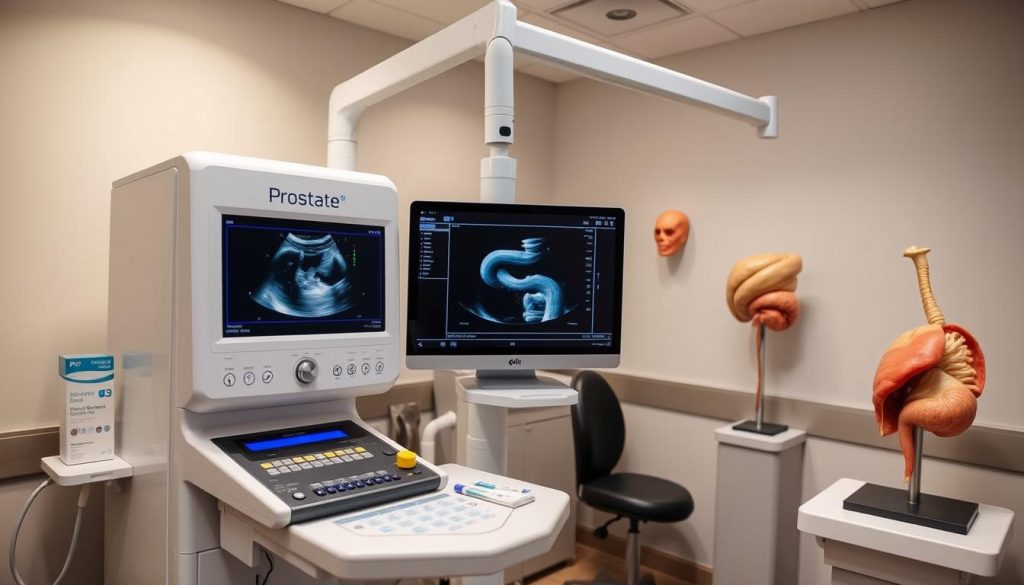
The PSA test checks for a protein made by the prostate gland. High levels might mean cancer, but can also show other issues. This blood test is often the first step in prostate cancer screening.
A DRE lets a doctor feel the prostate gland through the rectum. It looks for any odd sizes, shapes, or textures. While not as good as the PSA test, it can find problems the PSA might miss.
- PSA Test: Blood test measuring prostate-specific antigen levels
- DRE: Physical examination of the prostate gland
- Combination: Both tests are often used together for more accurate results
It’s vital to know these tests aren’t 100% accurate. They can sometimes give false positives or negatives. Men should talk to their doctors about the benefits and drawbacks of prostate screening. Regular check-ups and understanding prostate health are important for early detection and treatment.
Understanding PSA Tests and Digital Rectal Exams
Screening for prostate cancer uses two main methods: the PSA test and digital rectal exam. These tests help doctors find problems early.
PSA Level Interpretation
The PSA test checks the prostate-specific antigen in your blood. High levels might mean cancer, but can also show other issues. Here’s a quick guide to PSA levels:
| PSA Level (ng/mL) | Interpretation |
|---|---|
| 0-2.5 | Normal |
| 2.6-4.0 | Slightly elevated |
| 4.1-10.0 | Moderately elevated |
| >10.0 | Significantly elevated |
When to Get Screened
Screening advice changes based on risk. Men should talk to their doctor about starting tests:
- At age 50 for average-risk men
- At age 45 for high-risk men (African Americans, family history)
- At age 40 for men with multiple high-risk factors
Follow-up Testing Procedures
If tests show concerns, your doctor might suggest more steps:
- Repeat PSA test
- Free PSA test
- Prostate biopsy
- MRI of the prostate
High PSA levels don’t always mean cancer. Your doctor will look at many factors before deciding what to do next.
Diagnosing Prostate Cancer: From Screening to Staging
Diagnosing prostate cancer starts with screening and goes to detailed tests. The goal is to find out if cancer is there and how far it has spread.
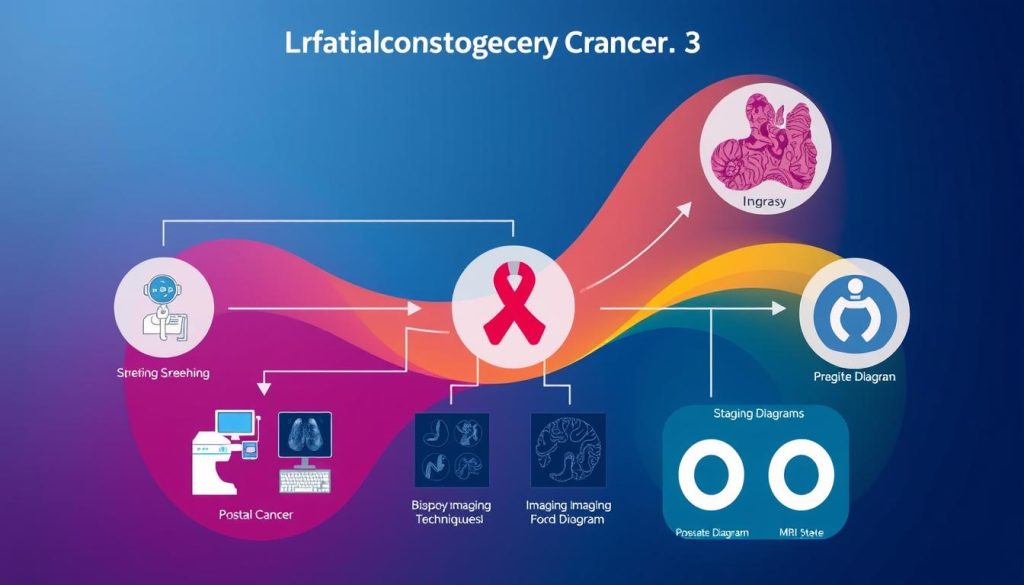
Screening often includes a PSA blood test and a digital rectal exam. If these tests show something wrong, your doctor might suggest a prostate biopsy. This test takes small tissue samples from the prostate to check under a microscope.
If cancer is found, the next step is staging. Doctors use MRI or CT scans to see if the cancer has spread. They also give a Gleason score to show how aggressive the cancer is.
The Gleason score is from 6 to 10, with higher numbers meaning more aggressive cancer. This score helps decide treatment. Your healthcare team will also consider your age, health, and what you prefer when choosing a treatment.
Getting a diagnosis can be tough. It’s key to ask questions and get support during this time. Your medical team is there to help and answer your questions at every step.
Treatment Options for Early-Stage Prostate Cancer
Patients with early-stage prostate cancer have several treatment options. Each one aims to manage the disease while keeping quality of life in mind. Let’s dive into these options.
Active Surveillance Protocol
Doctors might suggest active surveillance for low-risk prostate cancer. This means regular check-ups, PSA tests, and biopsies to watch the cancer. It’s a good option for those who want to avoid immediate treatment side effects.
Surgical Interventions
Radical prostatectomy is a common surgery. It involves removing the prostate gland and surrounding tissues. This can be done through open surgery or minimally invasive robotic-assisted surgery.
Radiation Therapy Approaches
Radiation therapy kills cancer cells with high-energy beams. There are two main types:
- External beam radiation: Delivers radiation from outside the body
- Brachytherapy: Places radioactive seeds directly into the prostate
Both radical prostatectomy and radiation therapy are effective for early-stage prostate cancer. The choice depends on the cancer stage, patient age, and overall health.
| Treatment | Pros | Cons |
|---|---|---|
| Active Surveillance | Avoids immediate treatment side effects | Risk of cancer progression |
| Radical Prostatectomy | Removes cancer completely | Risk of urinary and sexual side effects |
| Radiation Therapy | Non-invasive option | Potential for long-term side effects |
Advanced Treatment Strategies for Metastatic Disease
When prostate cancer spreads, doctors use advanced treatments. These methods aim to slow the cancer’s growth and ease symptoms. Let’s explore the main options available for patients with metastatic prostate cancer.
Hormone Therapy Options
Hormone therapy is a key treatment for advanced prostate cancer. It works by lowering testosterone levels in the body. This can slow or stop cancer growth. Common hormone therapy options include:
- Luteinizing hormone-releasing hormone (LHRH) agonists
- Antiandrogens
- Abiraterone
- Enzalutamide
Doctors may use these drugs alone or in combination. The choice depends on each patient’s case.
Chemotherapy Protocols
Chemotherapy uses drugs to kill cancer cells throughout the body. For metastatic prostate cancer, doctors often prescribe docetaxel or cabazitaxel. These drugs are given in cycles, with rest periods in between. Chemo can shrink tumors and ease pain in some patients.
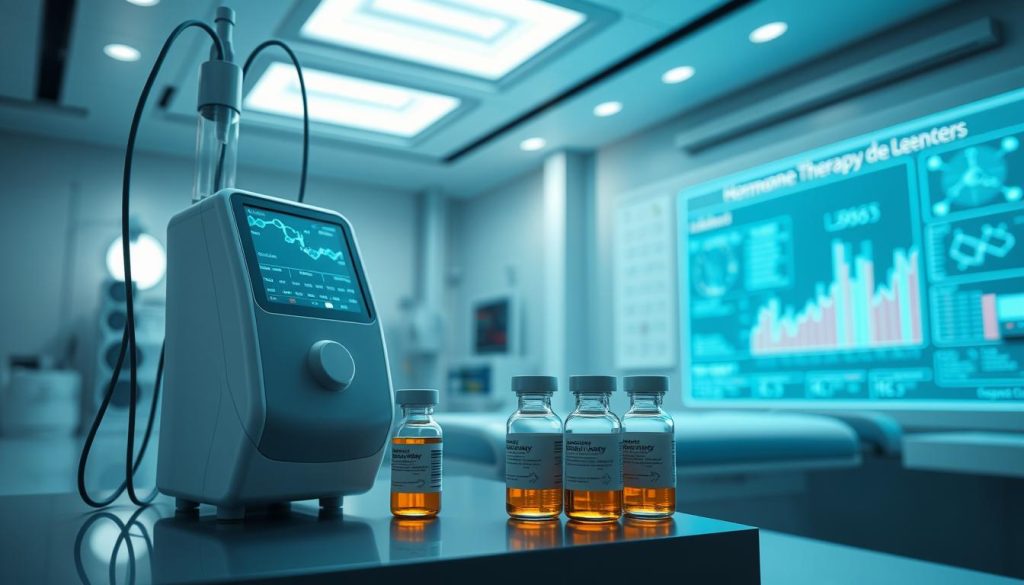
Immunotherapy Developments
Immunotherapy is a newer approach to treating advanced prostate cancer. It boosts the body’s own immune system to fight cancer cells. Sipuleucel-T is an FDA-approved immunotherapy for some men with metastatic prostate cancer. Research is ongoing to develop more immunotherapy options.
| Treatment | How It Works | Common Side Effects |
|---|---|---|
| Hormone Therapy | Lowers testosterone levels | Hot flashes, fatigue, weight gain |
| Chemotherapy | Kills cancer cells throughout the body | Nausea, hair loss, increased risk of infection |
| Immunotherapy | Boosts immune system to fight cancer | Fever, chills, fatigue |
Managing Side Effects During Treatment
Prostate cancer treatment side effects can be tough, but knowing how to handle them is key. Patients often face urinary issues, sexual problems, and feeling very tired during treatment.
Many men struggle with not being able to control their urine. Doing Kegels, which are pelvic floor exercises, can help. Some men also use absorbent pads or special underwear to deal with this issue. You can learn more about managing this side effect here.
Sexual problems, like not being able to get an erection, are common too. There are treatments like medicines, vacuum devices, or even penile implants. It’s important to talk openly with your partner and doctor to find what works best for you.
Feeling very tired is another big challenge. Eating well, drinking plenty of water, and doing light exercise can help. Rest is important, but so is staying active in a way that feels right for you.
- Discuss side effects with your medical team
- Explore support groups for shared experiences
- Consider counseling to cope with emotional challenges
Remember, how side effects show up can differ for everyone. Working closely with your healthcare team to find ways to manage them is vital. This approach can help improve your overall health and well-being during treatment.
Recovery and Rehabilitation After Treatment
The journey of prostate cancer recovery doesn’t end with treatment. It’s a process that requires patience, support, and dedication. Let’s explore the key aspects of recovery and rehabilitation to help you or your loved one navigate this important phase.
Physical Recovery Timeline
Prostate cancer recovery varies for each person. Most men start feeling better within weeks, but full recovery can take months. Urinary control often improves in 1-3 months, while sexual function may take 6-12 months or longer to return. Regular exercise and pelvic floor strengthening can speed up physical healing.
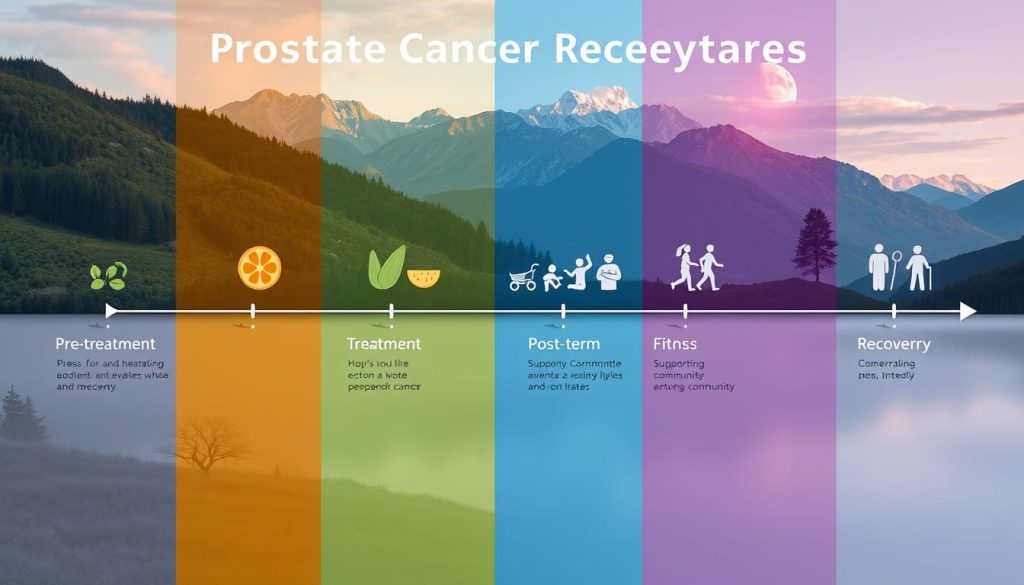
Emotional and Mental Health Support
Dealing with prostate cancer can be emotionally challenging. It’s normal to feel anxious, depressed, or worried about the future. Seeking support from family, friends, or professional counselors is key. Many hospitals offer support groups where you can connect with others going through similar experiences, which can be incredibly helpful during prostate cancer recovery.
Follow-up Care Plans
After treatment, your doctor will create a follow-up care plan. This typically includes regular PSA tests to monitor for recurrence, managing any lingering side effects, and addressing overall health concerns. These check-ups are vital for ensuring long-term wellness and catching any issues early. Remember, prostate cancer recovery is a journey, and staying engaged with your healthcare team is key to successful rehabilitation.
Living with Prostate Cancer: Quality of Life Considerations
Prostate cancer changes many parts of a man’s life. It affects his relationships, work, and daily activities. Patients face physical and emotional challenges that need support and ways to cope.
Maintaining intimacy can be tough because of treatment side effects. Talking openly with partners is important to deal with changes in sexual function. Some men find counseling helpful for relationship issues.
Work life may change too. Fatigue from treatments can impact job performance. Flexible schedules or reduced hours might be needed. Talking to employers about these options can help reduce stress at work.
Daily activities might need adjustments. Exercise routines might change to fit energy levels. Dietary changes could be needed to manage side effects. Setting realistic goals helps keep a sense of normalcy.
Support groups are great for improving quality of life with prostate cancer. Connecting with others who understand can offer comfort and advice. Many hospitals and cancer centers have these services.
Mental health is also key. Stress management techniques like meditation or yoga can help. Some men benefit from professional counseling to deal with emotions and develop coping skills.
By focusing on these quality of life issues, men with prostate cancer can strive to maintain well-being. They can find new ways to thrive despite challenges.
Latest Research and Emerging Therapies
The field of prostate cancer research is moving fast, bringing hope to many. Scientists are finding new ways to detect and treat this disease. For men at high risk, early detection methods are being tested.
These include advanced imaging that combines MRI with ultrasound for better biopsies. Prostate cancer research is also looking into hormone therapy, PARP inhibitors, and immunotherapy. These could help treat advanced stages of the disease.
Researchers are excited about PSMA-targeted radiation therapy. It aims to destroy cancer cells all over the body. Brachytherapy, a form of internal radiation therapy, is also getting better.
New techniques are making it more precise and effective. As trials go on, patients may get to try these new treatments soon. The future of prostate cancer care is looking up, thanks to ongoing research.
FAQ
Q: What are the early warning signs of prostate cancer?
A: Early prostate cancer often has no symptoms. But, some signs include frequent urination, trouble starting or stopping, and weak urine flow. Blood in urine or semen and pelvic discomfort are also signs. Remember, these can also mean other health issues, so regular check-ups are key.
Q: At what age should men start getting screened for prostate cancer?
A: Men should talk to their doctor about screening at:
– Age 50 for average risk
– Age 45 for high risk, like African Americans or those with a family history
– Age 40 for even higher risk, like those with a close relative diagnosed early
Q: What does an elevated PSA level mean?
A: A high PSA level doesn’t always mean cancer. Many things can raise PSA, like age and inflammation. Normal levels are under 4 ng/mL, but over 10 ng/mL is a higher risk. Always talk to a doctor about your PSA level.
Q: What are the main treatment options for early-stage prostate cancer?
A: Early-stage prostate cancer treatments include:
1. Active surveillance: Watching the cancer without immediate treatment
2. Radical prostatectomy: Removing the prostate gland
3. Radiation therapy: Killing cancer cells with high-energy rays
4. Focal therapies: Treating only the cancer area
The best choice depends on the cancer and your health.
Q: How effective is hormone therapy for advanced prostate cancer?
A: Hormone therapy can slow advanced prostate cancer. It lowers male hormones that cancer grows on. It’s not a cure but can help symptoms. But, cancer cells may become resistant over time.
Q: What are the possible side effects of prostate cancer treatments?
A: Treatments can cause side effects like:
– Urinary incontinence
– Erectile dysfunction
– Bowel problems
– Fatigue
– Hot flashes (with hormone therapy)
– Loss of bone density (with long-term hormone therapy)
– Changes in penis size and sexual function
Talk to your doctor about managing these side effects.
Q: Can prostate cancer be prevented?
A: No sure way to prevent prostate cancer, but lifestyle choices can help:
– Eat a healthy diet
– Stay active
– Maintain a healthy weight
– Limit alcohol
– Don’t smoke
Some studies suggest nutrients like lycopene and selenium might help, but more research is needed.
Q: What’s the survival rate for prostate cancer?
A: Prostate cancer survival rates are good, thanks to early detection. The 5-year survival rate for all stages is 98%. For early cancer, it’s nearly 100%. But, for advanced cancer, it’s about 30%. Survival rates vary based on many factors.












